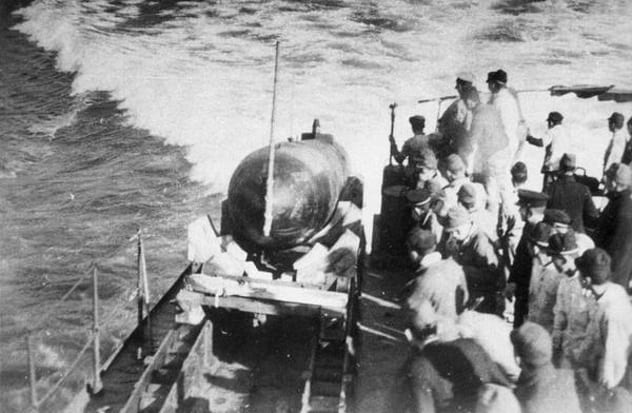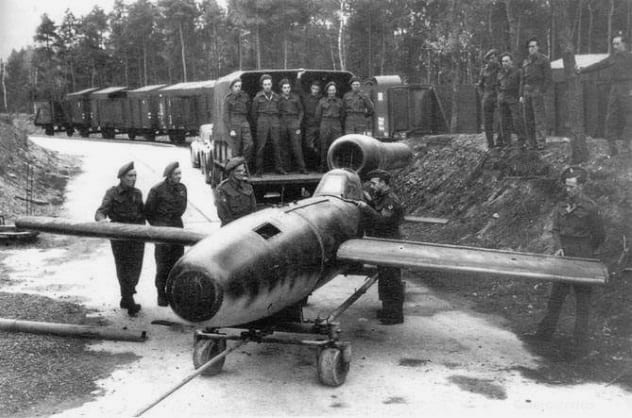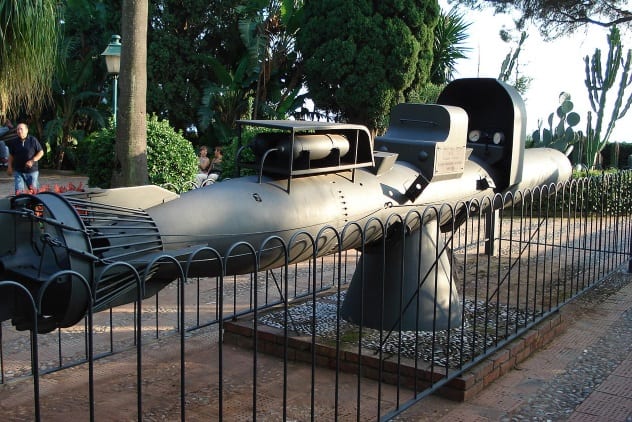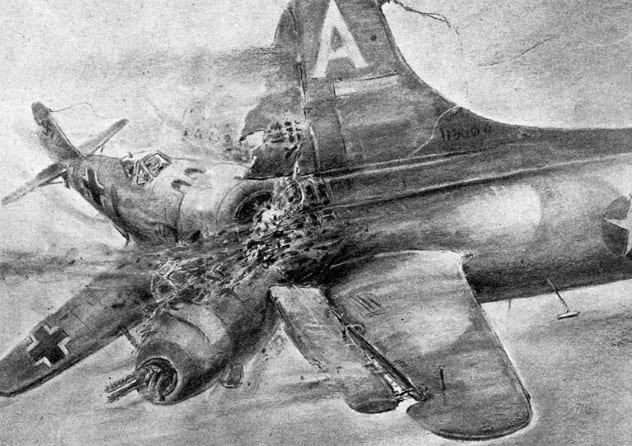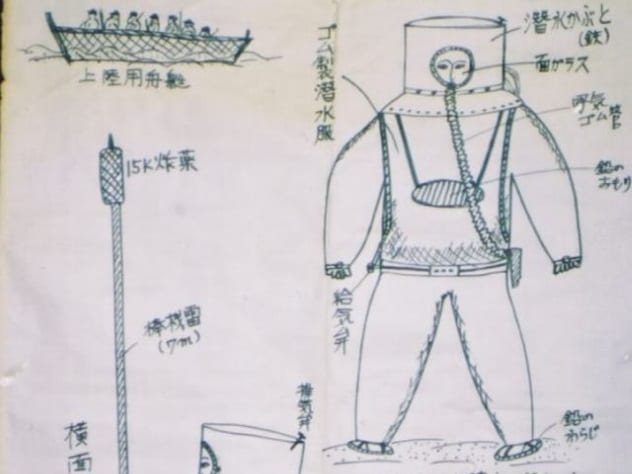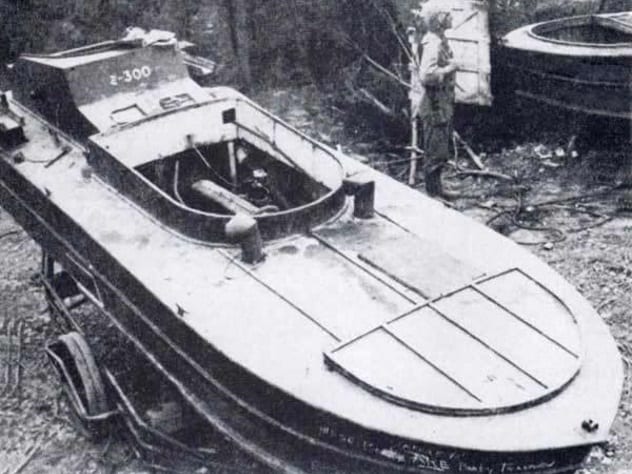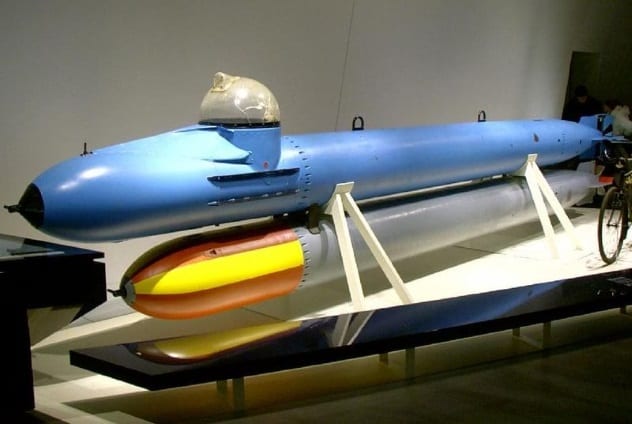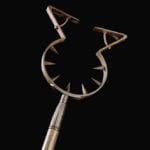Other nations developed crazier tactics, including putting men inside missiles. The United States Air Force almost did this, in fact. Below are ten bizarre times that various groups tried (and sometimes succeeded in) turning soldiers into suicide weapons.
10 Kaiten
The kaiten were the underwater version of the Japanese kamikaze airplanes. Like the airplanes, the pilots were expected to ram their torpedo submarines into enemy ships, killing the pilot and destroying the ship. Work started on the kaiten in February 1944, and a prototype was deployed in July the same year. The kaiten was more of a torpedo than a submarine. It was even powered by a torpedo engine. The pilot was only there to guide it to its target. The first prototypes allowed the pilots to escape as the torpedo moved closer to its target. However, most pilots were not interested in escaping. Later versions did not even allow them to do so. A kaiten pilot had two opportunities to hit his target. If he lost the second opportunity, he was expected to blow himself and the torpedo up. The kaiten’s inability to dive deep underwater was its greatest limitation, since it made it vulnerable to Allied attacks. Some missed their targets, and others did not explode even when they hit their targets. The Japanese navy did manage to successfully deploy kaiten against US ships, however. The USS Underhill was a notable casualty. It sank on July 24, 1945, after it was attacked by six kaiten.[1] Japan suspended kaiten attacks a week before it surrendered.
9 Fieseler Fi 103R
During World War II, Britain found itself at the receiving end of the infamous V-1 flying bombs fired from Nazi Germany territory. The V-1 attacks were as successful as they were scary. But they would have never been as scary as the Fieseler Fi 103R, the manned version of the V-1. By 1944, Germany was already losing the war and had started getting some crazy ideas. Someone thought it would be cool if they could launch manned missiles from bombers. The German high command bought the idea but thought it would be cooler if they just put a person inside a rocket. The V-1 was already successful, so it became the vehicle of choice. The pilot was not originally expected to die in the attack. He would just aim the Fi 103R at the target and bail out before it hit. However, this would have been impossible, since the escape would have interfered with the workings of the aircraft. However, unlike the V-1, the Fieseler Fi 103R would not be targeted at British cities. The V-1 was handling that already. Instead, the Fi 103R would have been aimed at Allied ships in the English Channel. Germany produced almost 200 Fieseler Fi 103Rs during the war. Fortunately for the Allies, the Nazis never deployed any, since the German high command was not really interested in the weapon.[2]
8 Proxy Bombings
While Islamist terrorist groups today will brainwash people with their ideologies before ordering them into bomb-strapped vehicles, the Irish Republican Army (IRA) used a more terrible and cowardly tactic during its decades-long war with the British government. The IRA targeted people with links to the British government. Holding their families hostage, the IRA ordered their victims to drive bomb-laden vehicles into British targets. The bombings were deadly and controversial. Sometimes, the driver only had moments to escape from the vehicle before it exploded. But they weren’t always that lucky. One notable victim of the IRA’s cowardice was Patsy Gillespie. In June 1990, he was forced to drive his wife’s vehicle—which had been rigged with bombs—to the police barracks in which he worked as a cook. He did, and the IRA left his family alone . . . for a while. Four months later, they returned and ordered Patsy to drive another bomb-laden vehicle to a military checkpoint. Patsy died in the explosion alongside five soldiers.[3]
7 Maiale
The maiale (Italian for “pig”) was a manned torpedo manufactured in Italy during World War II. Work started on the torpedo in 1935 over concerns that the Italian navy was surrounded by the British and French ships in the Mediterranean Sea. World War II broke out in 1939. The same year, Italy deployed the first maiale in the Mediterranean. The 5-meter-long (16 ft) maiale was armed with either a 300-kilogram (662 lb) warhead or two 150-kilogram (331 lb) warheads. Two crewmen rode the torpedo into the English and French harbors. Once under enemy ships, the crew detached the front part of the torpedo, which contained the actual warhead, attached it under the enemy ship, and escaped before it exploded. The maiale’s first deployment ended in failure. One was destroyed by an aircraft, and the other retreated after it was shot at. The maiale later found success in December 1941, when it sank two British battleships and a tanker in Alexandria, Egypt. However, the crew were captured before they could escape. The maiale remained in Italian service and was extensively used against British ships and Allied merchant ships until Italy signed an armistice with the Allies in September 1943. While it was a success, it was difficult to operate and was prone to sinking into the water. This was why it was called “The Pig.” Many torpedoes were lost during tests.[4]
6 Yokosuka MXY-7 Ohka
The Yokosuka MXY-7 Ohka was one of the infamous Japanese kamikaze airplanes. It was as deadly as it was feared. For a start, it was rocket-powered, which was unusual. The majority of airplanes used by the Allies were driven by propeller engines. The idea was simple. Once an Allied invasion was detected, Mitsubishi G4M2e bombers transported and released swarms of Ohkas toward the advancing Allied force. The Ohkas dived toward the enemy. Once they got close enough, the pilot fired the rocket engines, causing the deadly aircraft to speed toward their targets. The Ohka’s first combat deployment ended in disaster when all 16 bombers transporting them to the target were attacked and destroyed. Some bombers managed to release some Ohkas, but they were far away from their target. While Japan later found success with the Ohka and even used them against US ships, they were taken out of production because the bigger G4M2e bombers were vulnerable to Allied attacks.[5]
5 Sonderkommando Elbe
Sonderkommando Elbe was a special group of Luftwaffe (Nazi Germany air force) pilots trained to ram their airplanes into Allied aircraft. As we mentioned earlier, the tide changed toward the end of World War II, with Germany on the losing side, and the Germans had been getting crazy ideas. One was the Fieseler Fi 103R. Another was removing all weapons and armor from aircraft and ordering the pilots to ram them into Allied planes. The idea ended up worsening Germany’s situation. While Germany had better airplanes than the Allies, it did not have enough. The Germans didn’t have enough pilots or fuel, either. Turning their aircraft into manned missiles only reduced the number of planes and pilots at their disposal. While the pilots were expected to bail out of their airplanes before they crashed, it would not have been easy.[6] Germany’s idea of ramming airplanes into the Allies was not very successful in combat. While the airplanes destroyed some Allied bombers, Germany lost more aircraft than the Allies. Besides, while the Allies quickly and easily replaced their airplanes, the Germans could not so readily replace theirs, further worsening the situation of the Luftwaffe.
4 Bomi
The Bomi is straight out of the United States. Its name means “Bomber-Missile.” It was developed during the Cold War, at a time when the US and Russia were only concerned with developing new technologies to deliver nuclear warheads into the other’s territory. Bell Aircraft Corporation came up with the idea. They thought a pilot guiding an intercontinental ballistic missile into Moscow would be a good idea. The missile was divided into two compartments with a crew of three. A two-man crew manned the rear compartment and were responsible for launching the missile from base. The rear compartment detached in midair and returned to base, while the third crewman in the forward compartment flew into space before gliding into Moscow. The pilot would aim the missile toward the target before bailing out. This idea of bailing out sounds ludicrous, since the pilot would most likely have remained in the range of the 18,14-kilogram (4,000 lb) nuclear warhead. The US Air Force later dumped the idea because the missile could not reach Moscow. Besides, the US government was only interested in delivering nuclear weapons into Russia with either bombers or missiles, not with a hybrid of both.[7]
3 Fukuryu
The Fukuryu (Lurking Dragons) were the Japanese versions of today’s suicide bombers during World War II. The soldiers conscripted into the unit were armed with bamboo canes with 15-kilogram (33 lb) bombs at the ends. The divers would sneak into enemy harbors and attach the bamboo canes to ships. The resulting explosion would kill the divers and damage or sink the ships. Interestingly, the divers were more likely to die before they could strap the bombs to the ships. This was due to their unorthodox means of maintaining an oxygen supply. They connected their helmets to a tank containing caustic lye. The air they breathed out went into the tank, where it mixed with the lye to form oxygen, which they breathed in again. The idea was to breathe the clean air in through the nose and to exhale into a tube that led to the lye tank. Messing up this specific breathing pattern could quickly lead to unconsciousness. About 50 divers died during training after inhaling the lye. Sometimes, water entered the tank, turning the lye into a deadly gas. It was also normal for divers to get stuck in seaweed. Survivors who never detonated their bombs were no better. Many suffered respiratory issues and brain damage.[8]
2 Shinyo
At this point, we can all agree that the Japanese were so determined to stop the Allies from invading their territory that they used suicide attacks as a regular combat tactic. The shinyo (“sea quake”) boats were another suicide weapon deployed by the Japanese. They were modified torpedo boats containing deadly explosives. Two types of shinyo boats were developed. The first, which was designed for the navy, was rammed into enemy ships, killing the pilot and causing extensive damage to the ship. The other, which was developed for the army, was used to drop depth charges around the enemy ship before fleeing. The pilot was not supposed to die in the attack, though they sometimes did because the boats were not fast enough to vacate the area before the depth charges exploded.[9]
1 Marder
The marder was a small one-man submarine built in Nazi Germany. The submarine was not supposed to kill the operator even though it often did. It was an improved version of a similar submarine, the neger. The marder solved some of the neger’s problems, including its inability to remain underwater. However, the marder was not really better than the neger it was supposed to replace. While it could dive underwater, it could not do so beyond 30 meters (100 ft). For safety reasons, it usually remained between 13.7 and 15.2 meters (45–50 ft) below the water. Anything deeper was suicide. Both submarines carried one torpedo, which the pilot fired before fleeing the area. However, fleeing after firing the torpedo was difficult in both designs. While the marder was successfully used against Allied ships, it was still listed as an unsuccessful weapon since one third of the pilots died during missions.[10]
